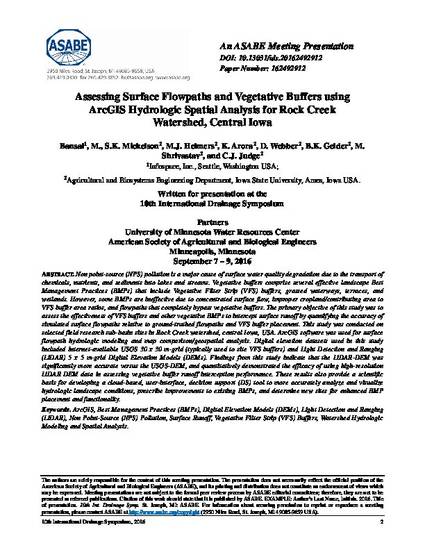
Non point-source (NPS) pollution is a major cause of surface water quality degradation due to the transport of chemicals, nutrients, and sediments into lakes and streams. Vegetative buffers comprise several effective landscape Best Management Practices (BMPs) that include Vegetative Filter Strip (VFS) buffers, grassed waterways, terraces, and wetlands. However, some BMPs are ineffective due to concentrated surface flow, improper cropland/contributing area to VFS buffer area ratios, and flowpaths that completely bypass vegetative buffers. The primary objective of this study was to assess the effectiveness of VFS buffers and other vegetative BMPs to intercept surface runoff by quantifying the accuracy of simulated surface flowpaths relative to ground-truthed flowpaths and VFS buffer placement. This study was conducted on selected field research sub-basin sites in Rock Creek watershed, central Iowa, USA. ArcGIS software was used for surface flowpath hydrologic modeling and map comparison/geospatial analysis. Digital elevation datasets used in this study included Internet-available USGS 30 x 30 m-grid (typically used to site VFS buffers) and Light Detection and Ranging (LiDAR) 5 x 5 m-grid Digital Elevation Models (DEMs). Findings from this study indicate that the LiDAR-DEM was significantly more accurate versus the USGS-DEM, and quantitatively demonstrated the efficacy of using high-resolution LiDAR DEM data in assessing vegetative buffer runoff interception performance. These results also provide a scientific basis for developing a cloud-based, user-interface, decision support (DS) tool to more accurately analyze and visualize hydrologic landscape conditions, prescribe improvements to existing BMPs, and determine new sites for enhanced BMP placement and functionality.
Available at: http://works.bepress.com/steven_mickelson/60/

This paper is from International Drainage Symposium, Paper No. 162492912, pages 1-7 (doi: 10.13031/IDS.20162492912). St. Joseph, Mich.: ASABE.